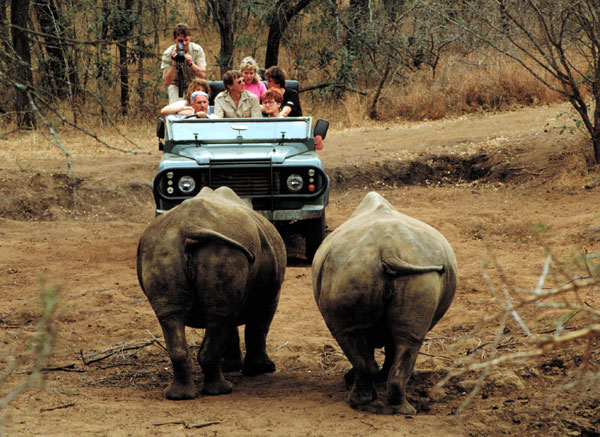(单词翻译:单击)
听力文本
This is Scientific American — 60-Second Science. I'm Jason Goldman.
Got a minute?
Public lands in the U.S. are managed with two goals in mind: protecting biodiversity and providing people with recreational opportunities, a chance to connect with nature. But sometimes those two goals are at odds—especially if recreation, activities like hiking or hunting, disrupts wild animals enough to alter their use of those landscapes.
Indeed, several years ago, a study done in California found that hikers had a negative impact on wildlife.
"That kind of sounded a bit of an alarm to us as wildlife biologists and as people who like to go hiking ourselves."
Wildlife biologist Roland Kays, of the North Carolina Museum of Natural Sciences and N.C. State University.
"We were pretty worried that if this problem was as bad as it seemed from that study, and was widespread, then there could be a real conflict between outdoor recreation and wildlife conservation."
To find out, Kays and his team enlisted the help of more than 350 volunteer citizen scientists, who deployed camera traps at nearly 2,000 sites within 32 protected areas in six different states. Roughly half of the areas allowed hunting and half did not. What they discovered was something of a relief.
"We found relatively minor impacts of hunting and hiking on wildlife."

It's not that human activities didn't impact wildlife at all of course. Heavily hunted species, like white-tailed deer, grey squirrels, and raccoons, were photographed somewhat less often in hunted areas. Coyotes showed up more often in hunted areas. While most species didn't avoid hiking trails, the predators actually preferred them.
But they did find something that had a much bigger impact on wildlife: habitat quality. The best predictor of wildlife abundance was not human activity, but factors like forest connectivity, nearby housing density, and the amount of adjacent agriculture. The results were published in the Journal of Applied Ecology.
And they suggest that outdoor recreation, a 646-billion-dollar industry in the U.S., is currently managed in a sustainable way, but also that protecting the scattered patches of wild habitat that remain in the U.S. is vital—both for wildlife and for people.
"Recreation, including hunting and hiking, and wildlife conservation, can coexist in the same place at the same time, and we can go out there and enjoy nature, enjoy the woods, hope to catch a glimpse of wildlife, without worrying about hurting the populations in the process."
Thanks for listening Scientific American — 60-Second Science Science. I'm Jason Goldman.
参考译文
这里是科学美国人——60秒科学。我是杰森·古德曼。
有一分钟时间吗?
美国公共土地管理有两个目标:一是保护生物多样性,二是为人们提供娱乐休闲、接近大自然的机会。不过有时这两个目标并不一致,尤其是像徒步旅行或狩猎这样的休闲活动,如果对野生动物造成破坏,足以改变他们对这些景观的使用。
事实上,几年前,加利福尼亚进行的一项研究发现,徒步旅行者会对野生动物产生负面影响。
“作为野生生物学家,作为喜欢徒步旅行的人,这就像是为我们敲响了警钟。”
罗兰·凯斯是北卡罗来纳自然科学博物馆和北卡罗来纳州州立大学的野生生物学家。
“我们非常担心,如果这一问题像研究发现的那样严重、普遍,那户外休闲活动和野生动物保护之间可能会发生真正的冲突。”
为了找到答案,凯斯和他的团队招募了350余名公民科学家志愿者,让这些志愿者在6个州的32个保护区设置相机“陷阱”近2000处。在这些地点中,约有一半地区允许狩猎,另一半则不允许。他们的发现令人松了一口气。
“我们发现狩猎和徒步旅行对野生动物的影响相对较小。”
当然这并不是说人类活动对野生动物没有任何影响。像白尾鹿、灰松鼠和浣熊等大量被捕杀的物种,在狩猎地区极少被拍摄到。土狼在狩猎地区经常出现。大多数物种没有选择回避徒步旅行的小径,捕食者实际上更喜欢它们。
但是他们的确发现了会对野生动物产生更大影响的因素:栖息地的质量。野生动物丰富的最佳预测指标并不是人类活动,而是森林的连通性、附近房屋的密度以及相邻农田的数量。这一研究结果刊登在《应用生态学期刊》上。
他们认为,作为美国价值6千4600亿美元的产业,户外休闲活动现在应以可持续的方式进行管理,另外,无论是对野生动物还是对人类而言,保护美国零散的野生栖息地是至关重要的。
“狩猎和徒步旅行等休闲活动,可以与野生动物保护在同一时间同一个地方共存,我们可以走出去,享受自然,希望能在森林里看到野生动物,而不用担心在这一过程中对它们造成伤害。”
谢谢大家收听科学美国人——60秒科学。我是我是杰森·古德曼。
译文为可可英语翻译,未经授权请勿转载!
重点讲解
重点讲解:
1. at odds (与…)不和;(与…)有矛盾;(与…)意见不一致;
例句:I think I'm at odds with you over the supply plan.
我想在供应计划问题上我们有分歧。
2. find out (尤指特意通过努力)发现,找出,查明;
例句:It was impossible for them to find out the truth.
对于他们来说,找出真相是不可能的。
3. not at all (用于表示强调)一点不,根本没有;
例句:As a matter of fact, I didn't know him at all.
事实上,我根本不认识他。
4. show up 出现;露面;
例句:Many TV stars show up in the evening party.
许多电视明星出现在晚会中。


